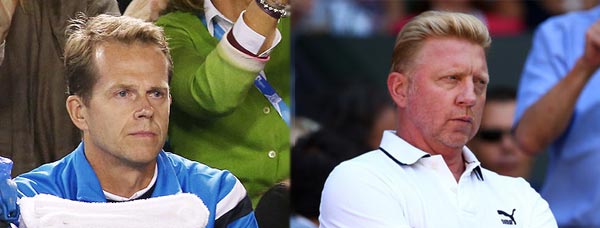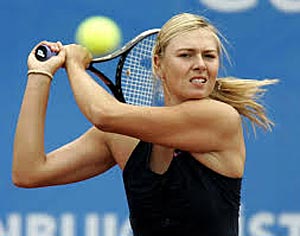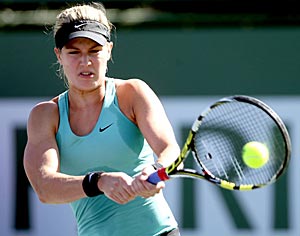|
TennisOne Lessons Tactics and Counter-Tactics at Wimbledon 2014 Paul Fein
Few sports test character as much as tennis. The Wimbledon classic between valiant competitors Novak Djokovic and Roger Federer proved that once again. Djokovic, the loser in three straight and five of his last six Grand Slam finals, surmounted that mental challenge with a dramatic 6-7, 6-4, 7-6, 5-7, 6-4 triumph. "I'm really glad my convictions were stronger than my doubts," he confided afterward. "I needed this win a lot." So much so that former world No. 1 Jim Courier predicted, "If he lost this match, it could have sent his career in a tailspin." Federer, the massive crowd favorite in the twilight of his legendary career, also battled ferociously and escaped a championship point in the fourth set with one of his 29 aces and then three break points in the middle of the fifth set. Few sports also require as much diverse stroke, footwork, and grip technique as tennis does. And here is where the 27-year-old Serb, taught the basics so superbly by his first coach, the late Jelena Gencic, is the undisputed No. 1 on both pro tours. Superior overall technique is the foremost reason Djokovic has reached 12 of the last 16 major finals in a Golden Era of men’s tennis and pulled out this tense, fluctuating duel. It gives him a potent offense and an almost impenetrable defense. Yet even the most resilient character, splendid strokes, dazzling athleticism, and endless endurance are not always enough to win the most coveted prizes in tennis, Grand Slam titles, as Djokovic had ruefully learned during the past 18 months. Tennis is a sport where victories sometimes hinge on mere inches and split seconds; and elite players are constantly seeking that edge, which they hope will make a difference between victory and defeat in close matches. So Djokovic hired as coach former star Boris Becker to get him over the mental hurdle, while Federer called on Stefan Edberg, Becker’s longtime archrival, to revive his declining career with some tactical tips. Becker dominated Edberg 25-10 when they battled on the court. Who would win this battle of coaching wits?
Tactics are intended to accentuate a player’s strengths as well probe and exploit an opponent’s weaknesses. No champion in history is more clever, versatile, and improvisational than seven-time Wimbledon champion Federer, particularly on grass. Before the final, the Swiss maestro revealed his overall strategy: “I think for me it’s really important to stay aggressive against him. And especially here at Wimbledon, it’s more simple how we need to play against each other. It’s not like on a slow court where you can maybe maneuver the other guy around so much. I think on grass it’s a bit more straightforward, and I think we’re both aware of that.” Then Federer explained why beating Djokovic, whom he led 6-5 in career matches at majors, would be so difficult. “We both like to be close to the baseline. We both like to take charge, especially on quicker courts. He has a wonderful way of either redirecting or taking the ball early, taking pace from the opponent, even generating some of his own. So I think that’s what makes him so hard to play. There’s not really a safe place you can play into. Novak can hurt you down the line or cross‑court on both sides.” The Edberg Effect After 34 career matches—Fed led 18-16—they certainly knew each other’s games inside and out. But Federer had served and volleyed in his previous six matches more than at any other Wimbledon since he grabbed his first title way back in 2003. Media analysts dubbed this new wrinkle for the ageless Federer the “Edberg Effect.” Edberg, one of Federer’s boyhood idols, served and volleyed to six Grand Slam titles from 1985 to 1993. In the final, Federer served and volleyed 38 times, which kept Djokovic guessing. The tactic backfired badly, though, on one of the match’s biggest points. After winning the first set tiebreaker, Federer was serving at 1-1 in the second set, down break point. He hit his first volley right to Djokovic and was easily passed. Just like that, Djokovic had reversed the match’s momentum.
Another Edberg tactic to break Djokovic’s rhythm and reduce his groundstroke superiority required even more boldness and skill. With Djokovic leading 40-15 in the opening game, Federer chipped a backhand and charged net off a second serve, and Djoker drilled a backhand crosscourt passing shot winner. On the first point of the slender Serb’s next service game, Fed wanted to use the same ploy but was foiled again when Djoker put some extra kick on his second serve and Fed erred. Federer had sent an early message, though, that he would attack—positionally, at least—as often as he could. Djokovic countered by mixing the placement, spin, and speed of his serves. Both of these calculated gambles usually paid off for Federer. He wound up winning 44 of 67 net approaches (66%). After the final, Djokovic commented, “He’s coming to the net more often. Those were particular changes in his game that I noticed before coming to this match. I paid attention to it and I was ready for it. Sometimes he played incredible volleys. At 4-3 [in the fifth set] on break point on second serve, he came in and played a half-volley winner. That’s why he has been winning so many Grand Slams, because he feels confident to play these shots at the important time.”
Only The Mighty Fed would and could serve and volley on a second serve—a counter-intuitive ploy—and pull it off to save the third break point of the must-win game. The crowd roared at the audacity and brilliance of the half-volley dying a foot from the net and the follow-up volley. Djokovic, sprawled on the grass, smiled in amazement. The daring escape allowed Federer to eventually hold serve and stay in the match. On the other hand, Federer occasionally committed the cardinal tactical sin of approaching the net with a crosscourt shot—a blunder Andy Roddick used to make against him—and was easily passed. After Federer lost the pivotal third set despite serving a phenomenal 13 aces, Courier, now a Tennis Channel analyst, criticized Federer’s serve return tactics: “Federer is playing too passively on serve returns. He needs to press the offensive button and not chip and charge because that doesn’t work against someone with Novak’s racket skills. He needs to rip it, if he’s going to come in.” That tactical advice, while sound in theory, was almost impossible for Federer to implement in practice because of Federer’s mediocre one-handed backhand. (Francesca Schiavone was the last one-handed woman to win a major, and Australian Open titlist Stanislas Wawrinka will likely be the last one-handed man, unless immensely talented Grigor Dimitrov does it. All of which makes it quite ironic that the inscription on the Gentlemen’s Singles Trophy, first presented by the All England Club in 1887, reads: “The All England Lawn Tennis Club Single Handed Championship of the World.”) Djokovic's Tactics The usual tactic to exploit Federer’s backhand is to hit to his forehand corner which then forces Federer to hit a running backhand. Djokovic did that, of course, but he also reversed that conventional wisdom by first eliciting an unthreatening backhand and then whacking it to Federer’s forehand corner to force errors there, too. That tactic prevented Federer’s no-longer-formidable forehand from dictating rallies. Without that strong forehand link to compensate for his weak backhand link, Federer managed to win only 26 of 59 (44%) of his second serve points. That was the killer stat for Fed because the more-balanced Djoker won an impressive 43 of 66 (65%) of his second serve points. Even though Federer insisted his new and much larger Wilson racket strengthened his backhand, which was reportedly 4 mph faster than a year ago, he produced only four backhand winners compared to 18 for Djokovic. IBM’s Aggressive Analysis, which measures a shot’s power, direction, depth, and point of origin on the court, gave Djokovic a huge aggression advantage, 58 to 34, for hitting bigger backhands. Besides that qualitative superiority, Djokovic was also more consistent, committing 41 total backhand errors compared to Federer’s 50. Not surprisingly, Federer’s backhand really broke down when it mattered most. In the pressure-packed, pivotal third-set tiebreaker, he erred on two backhand serve returns and returned another so weakly that Djokovic put it away. Then Federer sliced an unforced backhand error into the alley to give away the last tiebreaker point. When Federer got his only break point at 3-all in the deciding set, Djokovic smartly rushed net and Federer meekly sliced a backhand into the net. In the final game, Fed self-destructed with three unforced backhand errors to go down with an un-Federer-like whimper.
Murray's Realization After Andy Murray was overpowered by Wawrinka, Federer, and Nadal in his previous three Grand Slam events and failed to reach even any tournament final since winning the 2013 Wimbledon, he should have concluded passive tactics were ineffectual against top players. He should have studied videos that highlighted his aggressive tactics when he won the Olympics, the US Open, and Wimbledon during an 11-month span. After high-energy, purposeful Grigor Dimitrov overwhelmed him 6-1, 7-6, 6-4 with power and athleticism in the Wimbledon quarterfinals, Murray rightly realized he needed a bigger game to beat The New Generation, not to mention the Big Three of Djokovic, Nadal, and Federer. “I need to have a think about things, what are the things I need to improve and get myself in better shape and work even harder. Because everyone’s starting to get better,” the 27-year-old Scot acknowledged. “The younger guys are now obviously becoming more mature and improving all the time. Yeah, if you play against a player, you know, like a [Nick] Kyrgios or Dimitrov or [Milos] Raonic, and you don’t play very well, it’s tough to win those matches now; whereas [when they were] younger and a bit inexperienced, you can still find ways to come through them." Tactically, Murray, who fell to No. 10 in the rankings, must fight fire with fire and become a power player himself. That means attacking serve returns like Djokovic and belting forehands like Federer, as he did during his brilliant but short domination of men’s tennis. If second serve points won is the most important stat, as some “experts” assert, then it’s imperative that Murray add plenty of power and spin to his wimpy second serve. It averaged just 86 mph against Dimitrov and resulted in his winning only 10 of 32 second serve points, an abysmal 31%. In his four previous matches, the Murray second serve averaged an even-lower 83, 84, 82, and 82 mph. As 1987 Wimbledon champion Pat Cash pointed out in The Times (UK), “Some were clocked at only 78 mph, and frankly that is suicidal when your opponent is right on his game.” "Big Babe" Tennis Even though an astounding 57 of the last 59 Grand Slam women’s singles titles have been captured by power players, Eugenie Bouchard showed in the Wimbledon final that too much of a good thing isn’t good. Just as Dimitrov closely resembles Federer’s outrageous athleticism and scintillating shotmaking, Bouchard is often compared to Sharapova for her blond beauty, huge marketability, all-business demeanor, and “Big Babe” power tennis. And just as Dimitrov was annoyed by his “Baby Fed” moniker, Bouchard is adamant about achieving her own identity. “She’s a great champion. But I’m my own person,” says Bouchard. “I don’t want to be the next someone else. I want to be the first of me. I want to make my own history.”
Bouchard’s credo is “Do unto others before they do it to you.” She pushes “first-strike” tennis tactics to the limit—and sometimes beyond it. Reminiscent of relentless Monica Seles a generation ago, the 20-year-old Canadian stands a foot inside the baseline to return first serves and menacingly closer on second serves. Then she pummels the return. That positioning allowed Alizé Cornet, who had upset No. 1 Serena Williams, an average of only 1.95 seconds to react between the serve and the next shot, compared to 2.28 seconds for Bouchard. The 13th-seeded Bouchard, who looks like Princess Grace Kelly and fires bullets like sharpshooter Annie Oakley, also overpowered No. 20 Andrea Petkovic, No. 9 Angelique Kerber, and No. 3 Simona Halep, the highly talented French Open finalist. After losing 7-6, 6-2 to Bouchard, an impressed Halep said, “She is very focused. She’s tall. When she stays very close to the baseline, it’s like you see just her on court. She’s moving really well, so she’s everywhere on court. She’s a great player.” The go-for-broke tactics that worked so well against the undersized (5’6”) Halep, backfired against the 6’ left-hander Kvitova. To use a boxing analogy, the heavyweight Kvitova knocked out the light-heavyweight Bouchard with greater firepower, 6-3, 6-0. Kvitova, who whipped Sharapova in the 2011 Wimbledon final, blasted 28 winners compared to just eight for Bouchard. Tellingly, Bouchard made only four unforced errors, a peculiar statistic for a lopsided loser—until one considers that Kvitova hit virtually every ball so hard that almost all of Bouchard’s errors had to be forced. Kvitova’s power advantage was highlighted by an average serve return speed 17 mph faster than Bouchard’s (74 mph vs. 57 mph), a 12-mph difference (71 vs. 59) on backhands, as well as a 7-mph edge on first serves (106 vs. 99) and second serves (92 vs. 85). “This is some of the best tennis you’ll ever see on this court,” raved three-time Big W champion John McEnroe, now an ESPN analyst. “Kvitova’s hitting it so cleanly.” And Mary Joe Fernandez, the U.S. Fed Cup captain, called Kvitova’s virtuoso performance “power tennis at its best.”
Superior tactics and technique also played an important role in the Centre Court massacre. “I had great tactics from my coach,” said Kvitova. “I knew that I have to go forward for every shot to push her.” Kvitova pushed Bouchard around with brute power, the requisite topspin for control, and precise placement, but also finished her off, when necessary, at the net, winning 11 of 14 points (79%) there. Bouchard's Mistakes Kvitova didn’t need to, or want to, change her winning tactics. But Bouchard should have changed her losing tactics. Nick Saviano, her coach, has insisted that she focus on her rather one-dimensional game, not what her opponent is doing. ESPN analyst Chris Evert, who amassed 18 major titles using smart tactics, disagreed with that strategy, rightly arguing, “It’s always important to know what your opponent is doing—what shots they’re missing, what shots they’re hitting for winners. You have to make some [shot selection and positioning] calculations in your brain. It’s not just all about your game.” For starters, Bouchard will have to return the tour’s biggest serves from on, or even a foot or two behind, the baseline and trade some power for greater consistency. She needs to hit ‘through the ball’ more on her backhand to prevent occasional mis-hits and use less of a slugging motion, reminiscent of the Courier backhand, a flawed stroke. An erratic toss also causes her to lose service power, placement, and consistency. As a result, Bouchard averaged only two aces in her last four matches. Although Bouchard hasn’t captured a major this season, the self-assured Canadian has proved the most consistent contender, reaching the semis in Melbourne and Paris and the final at Wimbledon. At the same time, she was overpowered in her losses to Li Na, Sharapova, and Kvitova. Ranked a career-high No. 7, Bouchard needs to go back to the drawing board and figure out how changes in tactics and technique—which are inextricably linked—can take her higher. Former world No. 4 Gene Mayer, one of the smartest players of his era, offers this advice: “Bouchard plays the same way whether it’s working or not. She has an excellent game and temperament, but needs to build in variety. Some of the key areas are being able to topspin her forehand, slice her backhand, and play defense. With these improvements, she could become number one.” The hyper-ambitious Bouchard can find encouragement from the careers of Bjorn Borg, Pete Sampras, and Nadal. As they expanded their repertoire and incorporated new tactics, they racked up major titles and achieved superstardom. * * * * * Your comments are welcome. Let us know what you think about Paul Fein's article by emailing us here at TennisOne.
Paul Fein Paul Fein has received more than 30 writing awards and authored three books, Tennis Confidential: Today’s Greatest Players, Matches, and Controversies, You Can Quote Me on That: Greatest Tennis Quips, Insights, and Zingers, and Tennis Confidential II: More of Today’s Greatest Players, Matches, and Controversies. Fein is also a USPTA-certified teaching pro and coach with a Pro-1 rating, former director of the Springfield (Mass.) Satellite Tournament, a former top 10-ranked men’s open New England tournament player, and formerly a No. 1-ranked Super Senior player in New England. |


